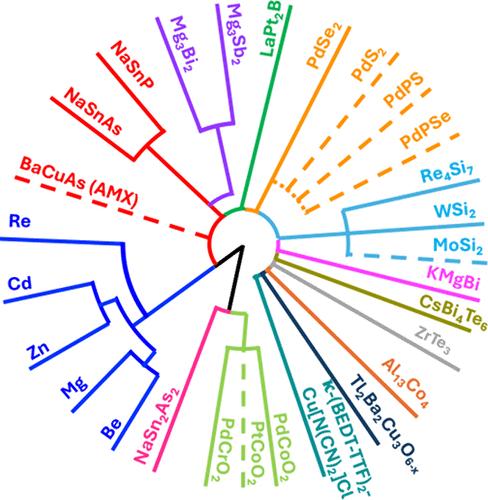具有轴相关传导极性的材料的磁场指南
IF 7
2区 材料科学
Q2 CHEMISTRY, PHYSICAL
引用次数: 0
摘要
大多数电子材料沿所有晶体学方向均匀地表现出p型或n型主导导电。然而,有一种新兴的材料,其主要的p型或n型导电性取决于晶体学方向。这种现象被称为轴相关传导极性(ADCP),并且已经在许多不同类别的材料中被实验检测到。在本文中,我们首先建立了这种现象的带结构起源和特征。然后,我们详细介绍了观察到ADCP的每种材料。我们提供了一个化学的理解为什么ADCP发生在这些材料中,并表明密切相关的等结构和等电子相也会表现出这种效应。这种对ADCP材料的动物学调查将为利用这种效应的电子设备概念的出现提供重要的参考。本文章由计算机程序翻译,如有差异,请以英文原文为准。

A Field Guide to Materials with Axis-Dependent Conduction Polarity
Most electronic materials uniformly exhibit either dominant p- or n-type conduction along all crystallographic directions. However, there is an emerging class of materials in which either dominant p- or n-type conduction is observed depending on the crystallographic direction. This phenomenon is referred to as axis-dependent conduction polarity (ADCP) and has been experimentally detected across many different classes of materials. In this Review, we start by establishing the band structure origins and signatures of this phenomenon. Then, we thoroughly detail each material in which ADCP has been observed. We provide a chemical understanding of why ADCP occurs in these materials and show that closely related isostructural and isoelectronic phases will also exhibit this effect. This zoological survey of ADCP materials will serve as an important reference as electronic device concepts exploiting this effect arise.
求助全文
通过发布文献求助,成功后即可免费获取论文全文。
去求助
来源期刊

Chemistry of Materials
工程技术-材料科学:综合
CiteScore
14.10
自引率
5.80%
发文量
929
审稿时长
1.5 months
期刊介绍:
The journal Chemistry of Materials focuses on publishing original research at the intersection of materials science and chemistry. The studies published in the journal involve chemistry as a prominent component and explore topics such as the design, synthesis, characterization, processing, understanding, and application of functional or potentially functional materials. The journal covers various areas of interest, including inorganic and organic solid-state chemistry, nanomaterials, biomaterials, thin films and polymers, and composite/hybrid materials. The journal particularly seeks papers that highlight the creation or development of innovative materials with novel optical, electrical, magnetic, catalytic, or mechanical properties. It is essential that manuscripts on these topics have a primary focus on the chemistry of materials and represent a significant advancement compared to prior research. Before external reviews are sought, submitted manuscripts undergo a review process by a minimum of two editors to ensure their appropriateness for the journal and the presence of sufficient evidence of a significant advance that will be of broad interest to the materials chemistry community.
 求助内容:
求助内容: 应助结果提醒方式:
应助结果提醒方式:


